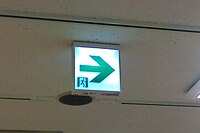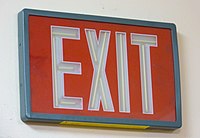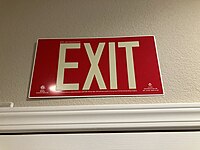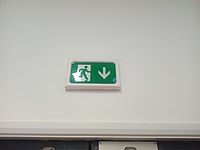Exit sign
An exit sign is a pictogram or short text in a public facility (such as a building, aircraft, or boat) marking the location of the closest emergency exit to be used in an emergency that necessitates rapid evacuation. Most fire, building, health, and safety codes require exit signs that are always lit.
Exit signs are intended to be unmistakable and understandable by anyone who can see. In the past, this generally meant exit signs that show the word "EXIT"[2] or the equivalent in the local language; increasingly, exit signs around the world are now pictograms, with or without supplementary text.[3]
History
[edit]Early exit signs generally either were made of metal and lit by a nearby incandescent light bulb[4] or were a white glass cover with "EXIT" written in red, placed directly in front of a single-bulb light fixture. A flaw in these designs was that in a fire the power to the light often failed. In addition, the fixtures, despite their brightness, could be hard to see through smoke. The biggest problem[citation needed] was that the exit sign was hardly distinguishable from an ordinary safety lighting fixture commonly installed above doors in the past. The problem was partially solved by using red-tinted bulbs instead.
Better signs were soon developed that more resembled today's modern exit sign, with an incandescent bulb in a rectangular box that backlit the word "EXIT" on one or both sides. Larger than its predecessors, this version of the exit sign was easier to see. The sign was still only useful as long as mains power remained on.
As battery-backup systems became smaller and more efficient, some exit signs began to use a dual-power system. Under normal conditions, the exit sign was lit by mains power and the battery was maintained in a charged state. In the event of a power outage, the battery would supply power to light the sign. Early battery-backup systems were big, heavy, and costly.[4] Modern systems are lightweight, can be installed virtually anywhere, and are integrated into the fixture, rather than requiring a separate box. As batteries improved, so did the amount of time that a fixture could remain lit on batteries.
While exit signs were more visible due to large letters, even a 60-watt incandescent bulb shining through a plastic or glass cover could appear somewhat dim under certain conditions. Incandescent bulbs are still in use because they are cheap and common, even though they use more electricity and require more or less frequent replacement. Incandescent bulbs lit 24/7 have a greatly extended lifespan compared to ones that cycle on and off. When used in exit signs, they are often operated at a lower voltage than rated, which further extends their lifetime, at the trade-off of reduced light output and greatly reduced energy efficiency.
With the development of fluorescent lamp and light-emitting diode technology, exit signs could be made even brighter to compensate for the limited visibility in a fire situation, while using less electricity. Fluorescent lamps are used in the same way as incandescent bulbs, back-lighting both sides of an exit fixture from within. LED signs combine a large number of bright light-emitting diodes to illuminate the sign from inside. An exit sign is constantly lit; fluorescent bulbs need to be changed more often than LEDs, although the absence of frequent on/off cycles extends the life of fluorescent lamps significantly. Generally, LEDs have a very long life, and may last for 10 years or more of continuous use, although their brightness may gradually diminish.
Radio-luminescent and phosphorescent signs that require no electricity have also been developed, and have been used since the 1970s. Radio-luminescence uses the radioactive decay of tritium gas to illuminate the sign,[5] while phosphorescence uses light-emitting pigments to glow in the dark. While both of these types of signs meet California State Fire Marshal standards, electricity is used in the vast majority of signs.
Modern installations
[edit]Most exit signs in the world, except in countries such as the United States, Canada, Australia, Hong Kong, Philippines, and Singapore, use pictograms. Australia, Canada, Singapore, and Hong Kong have changed their safety codes to encourage use of pictograms. The Philippines, which lacks a uniform standard, uses pictograms; signs reading "EXIT", "FIRE EXIT", or "EMERGENCY EXIT"; and combinations of pictograms and text.
In the United States, the National Fire Protection Association (NFPA) defines the standard for exit signs. NFPA 101 - 7.10.3.1 requires textual exit signs for all standard mounted applications; pictograms are allowed instead of or in addition to text if approved by local authorities and compliant with NFPA 170.[6] The NFPA has also approved the ISO pictogram as an option for low-level glow-in-the-dark signs.[7] New York City local law 26 requires these low-level pictograms in all high-rise buildings.[8] In tunnels, the Transportation Research Board recommends the ISO symbol.[9]
Newer Airbus, Bombardier CS100, and Boeing 787 Dreamliner planes use the new pictogram exit signs, which were approved by the FAA in 2012 and 2014 (depending on aircraft type).[10] The renovated Government Center subway station in Boston, and the MBTA's newer Type 9 streetcars for the Green Line and new Orange Line and Red Line trains made by CRRC, use signs bearing "EXIT" in white on a green background beside the ISO pictogram. Recent terminal renovations at the Albany International Airport have added supplemental ISO pictogram exit signs on terminal way-finding signs near the emergency exits. Parts of the Corning Museum of Glass use an exclusive variant of the ISO pictogram, pointing to exits, along with textual signs. The Cherokee Nation's Durbin Feeling Language Center uses the ISO pictogram instead of text.[11]
Modern exit signs often can be seen indicating the path to an exit in commercial and large residential buildings that comply with fire code. Certain circumstances, such as the year a building was built, create exemptions from some of these codes. In most situations, the owner of the building is responsible for complying with exit-sign requirements. This is especially true in older buildings that serve as multiple residences, such as apartment buildings, hotels, and campus dormitories.[12]
Modern fixtures are usually in a rugged plastic or metal housing securely bolted to the wall or ceiling. The signs have the word "EXIT", or a picture representing exit, on both sides. Single-sided signs are also available for wall-mount installations. The signs often have metal or plastic knock-outs which can optionally be removed so that an arrow is also lit pointing left or right. Modern exit signs are often combined with other safety devices, such as emergency floodlighting for supplementary area illumination.[13] Modern exit signs are also, to some degree, flame retardant.
Exit signs draw a relatively small amount of power, and can generally be added onto any existing electrical circuit without adverse effects. In addition, specialized LED lamps with "candelabra" sized screw-in bases are available to replace the always-on incandescent lamps in older exit signs. This allows the existing fixtures to be easily upgraded to save energy, without the expense of complete replacement.
Most recently, LEC (light emitting capacitor) exit signs have come to market. Also called electroluminescent (EL), these signs only consume 1/4 W of power, and have an operational life of 30+ years which far exceeds the typical 10-year life of an LED sign.[citation needed]
Non-compliance with building codes
[edit]It is often a serious offence for a building owner or landlord to not comply with the fire/building code in terms of Exit signage. In July 2016, for example, a fire in a Toronto apartment caused the death of one person and injured many others.[14] An investigation found that Emergency lights and Exit signs were not properly illuminated, and the landlord was fined about $20,000 for "not properly illuminating exit signs and having no record of emergency lighting tests", and another $50,000 for other infractions to the code.[15]
Lighting
[edit]Since visibility may be reduced in a fire, due to smoke or failure of electric lighting, the sign is often permanently illuminated, usually by one of:
- Radio-luminescence (or "self-luminous") where a phosphor coating inside a glass tube glows due to the beta decay of radioactive tritium gas sealed into the tube. Radio-luminescent exit signs are prohibited in US Department of Defense installations.[17]
- Photoluminescence (or "glow in the dark") use phosphorescence, where light absorbed earlier from the surroundings is slowly re-emitted
- Electric lighting, with a local rechargeable power source
- Electric lighting, with the building's emergency lighting circuits providing back-up power from a UPS or a generator in case normal power fails
Color and design
[edit]In most regions, including China, the European Union, Japan, and South Korea exit signs have green lettering. (In this color scheme, red is reserved to indicate prohibited activities.) In Australia, Canada, New Zealand, and most European countries, pictograms are used in place of the word "exit".[18] European sign directive 92/58/EEC of 24 June 1992 indicates that the signs should be green in color to indicate a safe place of exit. BS EN 1838:1999 and BS 5266-7:1999 also govern emergency lighting applications.
In the United States, exit signs can be red or green, but traditionally they have been red. Many states or cities have enacted building codes that specify the sign color. For example, in Baltimore, Salt Lake City, and Portland, Oregon[citation needed], green is required. New York City, Rhode Island, and Chicago (along with the rest of Illinois) require that exit signs be red.
New and renovated buildings in Canada are required to use the international standard green "running man" pictogram. The 1995 Canadian national building code required "red letters on a contrasting background or white letters on a red background ... spelling EXIT or SORTIE";[19] however, the 2010 Code calls for a switch from the red EXIT signs to the green "running-man" signs.[20] The national building code informs provincial and municipal building codes but does not have legal status itself. Most Canadian jurisdictions require the international green "running-man" pictogram; however, some have allowed red "EXIT" signs to be maintained in older properties so long as one style is used consistently throughout the building.[21]
Green fluorescent signs can be seen better in dark conditions than other colours, as the human rod cell is more sensitive to these wavelengths.[22][23]
Newly installed exit signs in Australia are green with a white "running man" figure (AS2293). Previously, green-written 'EXIT' signs were standard.
Accessible designs
[edit]There is a trend towards providing a more accessible, socially inclusive exit sign design based on universal design principles, including consideration for people with disabilities in the overall exit sign strategy for a building or facility.[citation needed]
The Accessible Exit Sign Project, which started in Australia in 2014 and has spread to New Zealand and the United States, is an international awareness campaign that promotes the need for an accessible means of egress. Advocates propose that appropriate exit signage to identify the accessible means of egress is a critical component to successful emergency planning for any building.[24]
The proposed new exit sign design features an "Accessible Means of Egress Icon", which includes an adaptation of the "running man" symbol with a new wheelchair symbol. The design is considered an enhanced version of the ISO 7010 and ISO 21542 accessible exit sign that shows the "running man" and International Symbol of Access at the end of the sign. The universally inclusive design with the "running man" and "Accessible Means of Egress Icon" wheelchair symbol essentially share the same upper torso, and the design shows the two moving through the door together. The Global Alliance on Accessible Technologies and Environments (GAATES) has stated that the introduction of the "Accessible Means of Egress Icon" onto exit signage changes the current discriminatory approach to emergency exit signs and presents a fully inclusive design.[25] "The combined ‘Running Man’ and ‘Accessible Means of Egress Icon’ […] are working together to escape the building. They move in unison, display the same urgency and motion and appear to be travelling at the same speed. Their heads are forward, showing their haste. Arms are extended and motioning back and forth as they move through the doorway."[25]
The accessible exit signs are now being produced in Australia, New Zealand, United States, and United Kingdom, also featuring braille and tactile lettering suitable for people that have low vision or are blind.[26] The design is intended to show where wheelchair accessible exit routes, evacuation lifts, evacuation devices and areas of refuge are located.[27] The concept also provides more intuitive building design to assist people that are blind or have low vision to locate an exit.[28] The design also meets the intent of the UN Convention on the Rights of Persons with Disabilities which requires signatory countries to consider the need for universal design in buildings.
See also
[edit]References
[edit]- ^ Jin, Tadahisa (December 2007). "誘導灯表示面のピクトグラフについて". Kasai. 57 (6). Japan Association for Fire Science and Engineering: 38.
- ^ The English word "exit" comes directly from the Latin word meaning "(he or she) goes out".
- ^ Turner, Julia (9 March 2010). "The Big Red Word vs. the Little Green Man: The international war over exit signs". Slate.
- ^ a b "Exit Signs". exitsignwarehouse.com. Archived from the original on 12 February 2018. Retrieved 13 October 2011.
- ^ "NRC: Backgrounder on Tritium EXIT Signs". nrc.gov.
- ^ "NFPA 101®, Life Safety Code®". Retrieved 21 November 2024.
- ^ NFPA 170 Standard for Fire Safety and Emergency Symbols. National Fire Protection Association. 2018. pp. 170–8.
- ^ "New York City Building Code Reference Standard RS 6-1 Photoluminescent Low-Level Exit Path Markings - Other News - News | American Society of Safety Engineers". www.asse.org. Retrieved 13 March 2018.
- ^ Tamory Winfield (13 January 2016). "NEW FIRE EXIT SIGNS ARE PROACTIVE SAFETY MEASURE IN HARBOR TUNNEL" (Press release). MDTA. Archived from the original on 27 January 2016.
- ^ "Identification and Comprehension of Symbolic Exit Signs for Small Transport-Category Airplanes" (PDF). FAA.gov. US Federal Aviation Administration. February 2012. Retrieved 13 March 2018.
- ^ "Cherokee Nation opens $20 million immersion facility where English becomes a foreign language". Native Oklahoma. 15 November 2022. Retrieved 21 November 2024.
- ^ Olander J.; Ronchi E.; Lovreglio R.; Nilsson D. (2017). "Dissuasive exit signage for building fire evacuation". Applied Ergonomics. 59 (Pt A): 84–93. doi:10.1016/j.apergo.2016.08.029. PMID 27890163.
- ^ "LED Blade Exit Light With Spotfire".
- ^ "CBC Canada".
- ^ "Toronto Star". Toronto Star. 18 July 2016.
- ^ "Emergency Lighting / EXIT Signage Testing Requirements". Brighton Town Hall. Retrieved 15 October 2014.
- ^ "Unified Facility Criteria (UFC) 3-600-01" (PDF). Archived from the original (PDF) on 6 February 2009. Retrieved 4 February 2009.
- ^ "What is Emergency Lighting?". WBS Technology. 5 July 2024.
- ^ "Lighting Reference Guide – Exit Signs". National Resources Canada. Archived from the original on 17 July 2012. Retrieved 15 September 2011.
- ^ Carss, Barbara (October 2010). "Traditional Signs to EXIT in Favour of the Running Man". Canadian Property Management. Archived from the original on 28 February 2013. Retrieved 6 July 2015.
- ^ "Policy on Exit Sign Installations in Existing Buildings" (PDF). June 2011. Archived from the original (PDF) on 21 September 2011. Retrieved 6 July 2015.
- ^ Stryer, L (2002). Biochemistry. New York: W H Freeman. pp. 32.3.1.
- ^ Bowmaker, J K; Dartnell (1980). "Visual pigments of rods and cones in a human retina". Journal of Physiology. 298: 501–511. doi:10.1113/jphysiol.1980.sp013097. PMC 1279132. PMID 7359434.
- ^ "Why are accessible exit signs important?". Accessible Exit Sign Project. 9 March 2014. Retrieved 14 March 2015.
- ^ a b "The Accessible Exit Sign Project". GAATES Global Accessibility News. Retrieved 14 March 2015.
- ^ "Accessible Signs in New Zealand" (PDF). The Professional Engineer (85): 3. February 2015. Retrieved 14 March 2015.
- ^ Miller, Mark. "Accessible Exit Signs". Interactive Accessibility. Archived from the original on 6 April 2015. Retrieved 14 March 2015.
- ^ Wilson, Lee (March 2015). "Planning for Evacuating People with Disability". International Fire Protection Magazine (61): 48–50. Retrieved 14 March 2015.
External links
[edit] Media related to Exit signs at Wikimedia Commons
Media related to Exit signs at Wikimedia Commons














